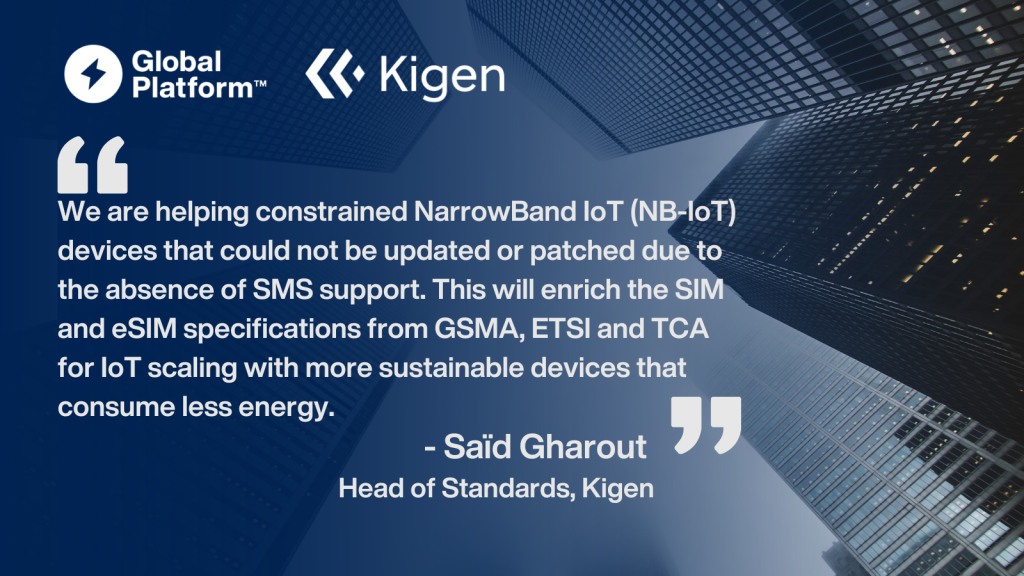
- Resources
- Blog
- News
CoAP Support for NB-IoT
2024 Kigen Partnership News – Standards for NB-IoT enhanced

14 May, 2024 – London – GlobalPlatform, the standards organization for secure digital services and devices, has released a new standardized Secure Channel Protocol for secure elements, enabling remote application and file management on constrained IoT devices and low-power networks. This latest update will help stakeholders to accelerate the adoption of robust end-to-end security in IoT devices, comply with IoT cybersecurity regulations, manage updates and patches, save energy, and simplify device management.
“GlobalPlatform’s widely adopted Secure Channel Protocols enable the successful deployment and management of secure elements for multiple markets and use cases,” commented Gil Bernabeu, GlobalPlatform CTO.
Saïd Gharout, Head of Standards at Kigen who is a member of GlobalPlatform’s SE Committee that led the development of the specification, added: “This new protocol by GlobalPlatform is a huge leap forward for IoT sustainability and security. We are helping constrained NarrowBand IoT (NB-IoT) devices that could not be updated or patched due to the absence of SMS support. This will enrich the SIM and eSIM specifications from GSMA, ETSI and TCA for IoT scaling with more sustainable devices that consume less energy.”
Saïd Gharout also Chair of the GSMA eSIM Working Group 2 that oversees Technical Specifications such as SGP.22 and SGP.32.
Gloria Trujillo, eSIM Group Technical Director, at the GSMA welcomed GlobalPlatform’s new protocol which, alongside the GSMA’s new eSIM IoT specifications as defined in SGP.31 and SGP.32, enables the creation of a secure ecosystem to support the rapid proliferation of network constrained IoT devices.
“Network and bandwidth limitations of IoT Devices have been a concern for the telecoms industry, and enterprises alike for some time now,” said Trujillo. “This has taken on greater importance given the increasing global adoption of these types of connected device in critical business environments. The emergence of GlobalPlatform’s new protocol alongside our new eSIM IoT specifications assure the industry that we have a secure, robust ecosystem to support and accelerate IoT rollout.”
Supporting the next generation IoT use cases
GlobalPlatform’s new protocol supports IoT secure element manufacturers, application developers, device makers, module makers and platform providers across a wide range of use cases including:
- Single charge battery powered devices (e.g. emergency buttons and trackers) – for less energy-demanding transactions.
- Smart metering, especially water meters – to help reduce power consumption and encourage more sustainable practices, while extending the life of devices.
- Automotive – to enhance in-car connectivity, asset tracking and vehicle-to-vehicle communication.
- Smart cities – to automate and optimize data transfer for a number of urban functions such as traffic management and pollution control in a sustainable, cost-effective way.
Newsletter Sign-up// – Light Gray Inline
Sign-up for our newsletter to receive the latest from Kigen.
Standardizing protocols for the IoT age
To communicate over Low Power Wide Area Networks (LPWAN) like NB-IoT, new communication protocols have been adopted:
- User Datagram Protocol (UDP) replaces Transmission Control Protocol (TCP) – to enable faster data transmission and limit bandwidth requirements.
- Constrained Application Protocol (CoAP) replaces Hyper Text Transfer Protocol (HTTP) – to optimize the size of data packets and reduce power requirements.
- Datagram Transport Layer Security (DTLS) replaces Transport Layer Security (TLS) – to provide end to end security.
“As the ecosystem and technologies evolve, increasingly optimized mechanisms like this are needed to facilitate the deployment and management of robust security. Operators will now be able to update their (e)SIM using this protocol,” continued Bernabeu. “Support for IoT network-constrained devices is critical if we are to achieve net zero worldwide by 2050, while optimizing performance and providing end-to-end security.”
Read the full release here.
Additional resources
Download the Remote Application Management over CoAP document, which can be found here.
Learn more about the work of the Secure Element Committee at GlobalPlatform.


